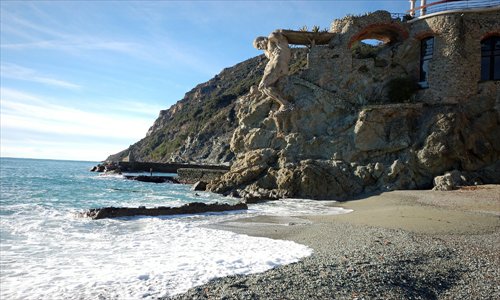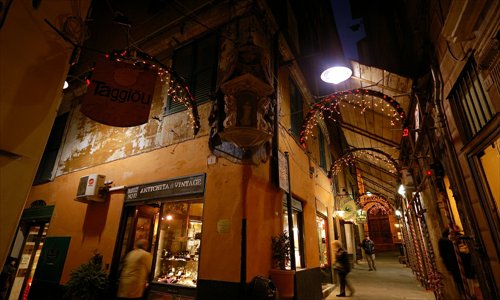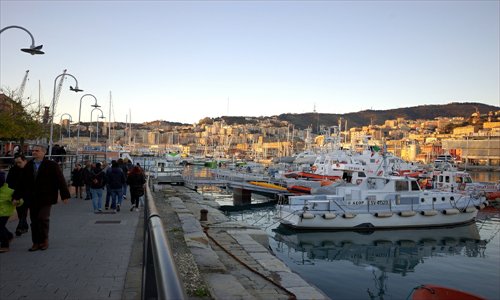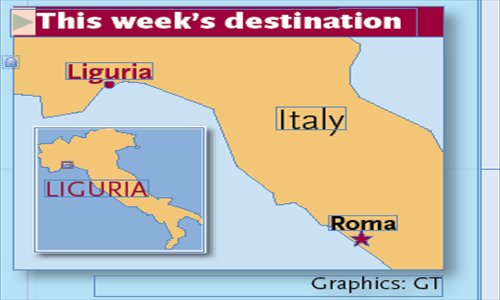The pride of Italy




Considered by many to be Italy's version of the French Riviera, Liguria's eastern coast, declared a UNESCO World Heritage Site in 1997, is connected to the modern world in two ways: by rail and by trail. Cinque Terre (Italian for "Five Lands") is a fragile cluster of five villages, Monterosso sul Mare, Vernazza, Corniglia, Manarola and Riomaggiore, perched on steep cliffs and defined by a breathtaking view of quaint, colorful houses and green terraces that from afar resemble rice farms in Yangshuo. The Cinque Terre are packed with tourists and full of bustle especially in the manic summer months. During my winter visit, I almost had the maze of narrow alleys that constitute the cities' planning all to myself. Almost.
Blazing a trail
The whole area, spread out along the region's coastline, enjoys relatively mild winter temperatures thanks to its proximity to the sea, but rainfall is not rare and very much feared. The day I arrived, my scenic walk was slowed down and made more dramatic by a persistent, ice-cold rain. I had planned to travel from the medieval town of Levanto towards Bonassola to the resort village La Francesca, nestled on a wide valley from which you can't see anything except for the azure sea. Thankfully, the rest of my stay was blessed with warm sunshine, and I soaked up the splendor of the area whose beauty is undiminished by age.
Although widely known as medieval centers, the Cinque Terre date back to Roman times. After succumbing to the power of different aristocratic families, in 1276 they were eventually incorporated in the mighty Republic of Genoa, "la Superba" (the Proud), as it was affectionately labeled by 14th-century Italian poet Petrarch.
The terraced fields planted with vines and olive trees clothe the hillside, populating the views from the towns' harbors and revealing the pastoral spirit of the gentle society. While nowadays the main source of wealth is undoubtedly the tourism business, all five towns have farming origins, their first inhabitants having painstakingly built dry stone walls in order to prevent the mountainside from sliding. While today the most popular areas are the harbors, originally life was intentionally organized at higher altitudes to thwart pirates.
Starting from Levanto, my first stop was Monterosso sul Mare, typically the epitome of an elegant beach resort. Of all five towns, Monterosso is the only one that boasts a long sandy beach, and a majestic statue of Neptune, the Roman god of the seas, greets first-timers and regular vacationers alike.
While relatively similar, each village bears its own peculiarities. My favorite among the Cinque Terre was Vernazza. As soon as I arrived this town unfolded in a picturesque labyrinth of cobbled lanes and stairways wide enough for barely two people to pass at a time. The magic was alluring and I soaked in its atmosphere, all spruced up for the Christmas season. Hobbit-like houses leaned over narrow paved stairways and steep alleys were festooned with laundry hanging from the windows, almost as if to assert their Italian style.
Tales of survival
A little more than a year ago, the Cinque Terre were hit by a nasty flood. A typical annual rainfall poured down in a mere four hours, leaving Vernazza devastated and the rest of Italy in shock. For the inexperienced eye, the scars of this tragedy that took the lives of three residents are not visible, but in Vernazza's collective memory this flood has left an indelible mark. When I finally decided to grant myself a well-deserved break after exploring the village's backstreets, I entered the quaint Trattoria da Sandro and ordered one of my favorite local dishes: ravioli in walnut sauce sprinkled with cinnamon. I was enjoying my lunch when I overheard a conversation the owner of the restaurant was having with the customers at the table next to mine.
"During the flood, the debris of an entire mountain came down and covered almost the whole village," she told them. "The restaurant got completely surrounded. We are alive only because we weren't here at that moment... We had to rebuild everything, from the electrical system to the water pipelines, from scratch." If I had needed any confirmation, that moment made it clear that even though more than a year had past, the wounds are still wide open.
After lunch, I felt strong enough to explore the unique treasures that lay ahead. I panted up to the ruins of a medieval castle and took a moment to admire the view of the Mediterranean before heading to Riomaggiore, which was allegedly founded by Greek refugees. The nearby Corniglia was precariously built on a hilltop. In Manarola, the nights before Christmas are lit up by the characters of the Presepe, a traditional Catholic nativity. The town's is the biggest in the world, built on the dominating Monte delle Tre Croci (Mount of the Three Crosses) facing the local San Lorenzo Church. As the harbor and the sea play a pivotal role in these small societies, it's not unusual to find locals' boats pulled up on the main squares during winter, forming the perfect postcard view against quaint pastel houses. I stood on Vernazza's harbor for about twenty minutes, mesmerized by the waves regularly breaking on the uneven rocks, enjoying that corner of whimsical coast all to myself.
Visit to the big city
The laid-back atmosphere of this idyllic Italian getaway spoiled me in those two days, but I wasn't willing to go back home without paying tribute to Genoa, the wonderful city that still carries the flavors of her glorious past as a maritime capital. Built along some twenty kilometers of coastline, Genoa has always been a merchant's haven, and the signs of the eternal battle between religious and secular powers are easy to identify, with the coat of arms of the former city-state, the red St George cross held by two griffons, and Janus, the two-faced Roman god, featured on churches.
I had been to Genoa before, but I never really had the chance to take in its renowned maze of narrow alleys, or carrugi in the local dialect. This time I had an outlandish and extraordinary character as a guide, Mario, a childhood friend who's been living there for 15 years. A tattooed tea connoisseur, Mario ambled about the tangle of cobbled lanes embarking on a colorful tale covering the city's main attractions, listing them and embellishing the narrative with legends and anecdotes, briefly pausing from time to time to send a look of disapproval my way for devoting so little time to such a cultural and historical center.
As the capital of the Italian region Liguria, commerce has always been the cornerstone of Genoa's prosperity thanks to its thriving port. Today, with a population of around one million, it's the perfect blend of modernity and tradition, and although it doesn't have the typical manicured elegance of most tourist cities, meandering through its carrugi, each of which bears its own stormy past, gives the impression of stepping into the Middle Ages.
"Can you imagine how many people entered this church?" wondered Mario in awe as we stepped over the threshold of the San Lorenzo Cathedral, a finely decorated architectural masterpiece.
The former maritime center
The legendary alleys of the city's medieval quarter, the biggest in Europe, exude an erudite yet down-to-earth ambiance. I loved imagining Genoa in its heyday a few centuries back, busy with commerce all over the seas, before its native son Christopher Columbus diverted trade away by opening the Atlantic route toward the Americas. Back then the port city managed pilgrims and Crusaders headed to and from the Holy Land, and it also fought Venice, the other republic, "la Serenissima" (the Most Serene), over the control of the seas. It was during one of these naval battles that Genoa captured Venetian merchant and traveler Marco Polo on his way back from China. He was imprisoned for four years, at the end of his journey along the fabled Silk Road reported in Il Milione, written from his Genoese prison with the aid of his cellmate and writer Rustichello da Pisa.
Lingering in Genoa's carrugi teeming with Christmas shoppers, enjoying the decorative lights flittering above my head and listening to Mario's beguiling narrative punctuated by names I'd studied in school, I could not fathom leaving. But time was flying, and on my way to the docks I decided that the best way to round off a long but rewarding day was to buy myself a slice of farinata, a typical Genoese dish traditionally for the poor, consisting of baked chickpea flour, water, salt and olive oil, to savor on the ferry that would take me back home.
"How can you leave Genoa without visiting Nervi, the fishermen's district?" said Mario casting a glance at me, just to make sure he'd gotten his point across. Strolling along the Old Port, pausing only a moment to take in the flickering city lights reflecting on the calm waters, I reassured him that I'd be back, because if I like a place, leaving something unseen is the best premise for a new trip.
Rules of Thumb
Practical information: The local currency in Italy is the euro, with Cinque Terre likely among the most expensive areas in the region. However, it's possible to book a hotel, hostel or bed and breakfast in neighboring cities such as La Spezia and Bonassola, with prices starting from 30-40 euros ($40-$52) per night. All five villages of the Cinque Terre have restaurants serving main local dishes with prices ranging from 12 to 15 euros per course.
What to say: English is seldom spoken in Italy and it's always recommended to carry a small dictionary, a map and a guidebook for reference. Tourism offices may have English-speaking staff. Menus and explanations at tourist sites are usually bilingual.
What to wear: Mountains protect the Cinque Terre from north winds but winters here can still be quite cold. April, May and June are the best months to visit the region. All five villages are built on steep slopes and buses don't run there, so be sure to wear comfortable shoes.
For more info on activities and places to see in the Cinque Terre, visit http://www.cinqueterre.it/info.